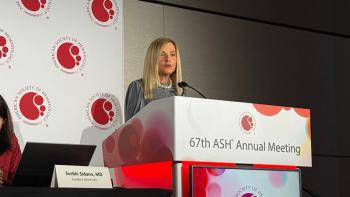
Dr Liz Zhou Explains Basal Insulin Switching Study on Toujeo
Liz Zhou, MD, director of evidence-based medicine at Sanofi Medical Affairs outlined the purpose of a study on real-world results of comparing basal insulin dose changes in type 2 diabetes patients using Lantus who either stay on Lantus or switch to Toujeo.
Liz Zhou, MD, director of evidence-based medicine at Sanofi Medical Affairs outlined the purpose of a study on real-world results of comparing basal insulin dose changes in type 2 diabetes patients using Lantus who either stay on Lantus or switch to Toujeo.
Transcript
Explain the research rationale of the EDITION 1 & 2 trials.
As we all know, insulin glargine 300, which is called Toujeo, was approved in the US in early 2015, and in EDITION 1 and 2 trials, both of them are looking at basal switch population. EDITION 1 trial are patients on basal plus meal-timing insulin, and EDITION 2 is basal plus [oral antidiabetic drug]. For both of those in those trials, we can see that patients randomized to Toujeo use 10% more basal insulin compared to patients randomized to Lantus. But how does insulin dose differ between Toujeo and Lantus in the real-world setting is the question that we are hoping to examine in this study. We are looking at Optum Clinformatics data, which is a claims database to answer this question.
How did real-world results follow-up on and expand previous trials?
In this study, we are comparing basal insulin dose change in type 2 diabetes patients who are using Lantus in prior who either switch to Toujeo or remain on Lantus and we are looking specifically into the percent change in daily average consumption, which is called “day con,” in the inpatient from baseline to follow-up. What we did is we matched two cohorts in demographics and clinical characteristics, which is trying to mimic the setting the EDITION 1 and 2 trials, because of the 2 arms. What we have found in the study is that compared to continuing on Lantus, switching to Toujeo is not associated with higher basal insulin dose, and we also observed similar change in A1C and day con between the 2 cohorts. So this is slightly different from what we see in the clinical trial setting, but that’s what we observed in the real-life data. And that’s, I think, a lot of the questions on the payer’s or clinician’s mind.
Newsletter
Stay ahead of policy, cost, and value—subscribe to AJMC for expert insights at the intersection of clinical care and health economics.









































